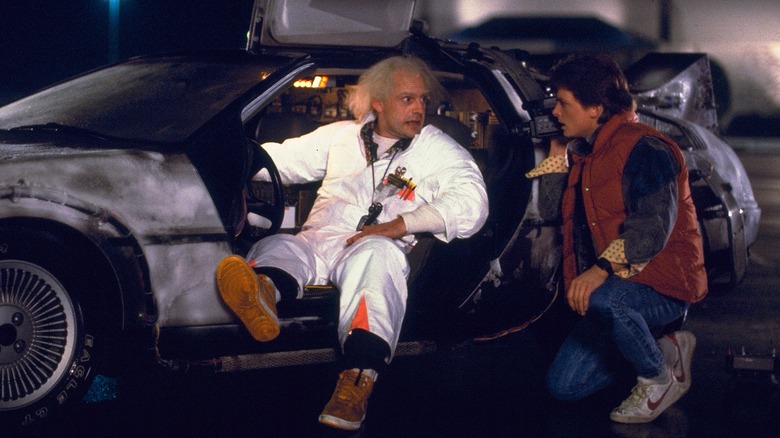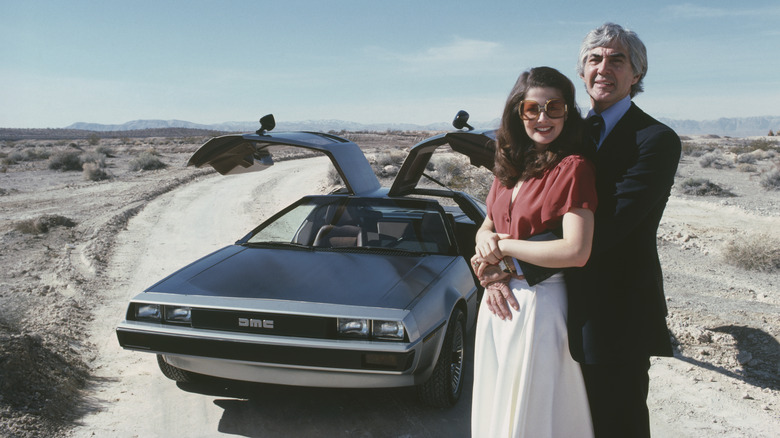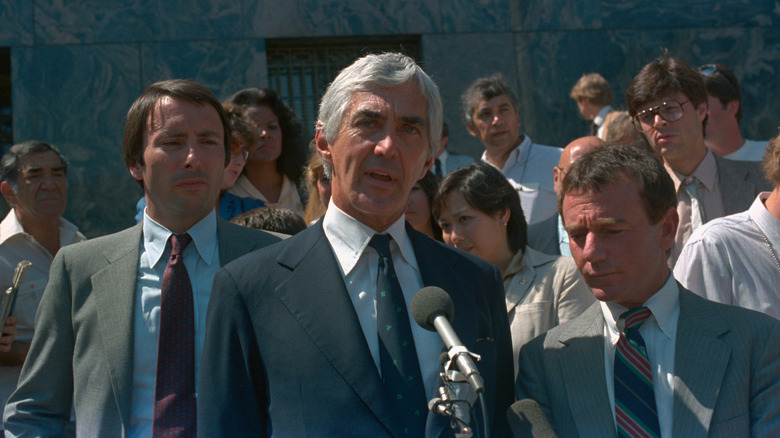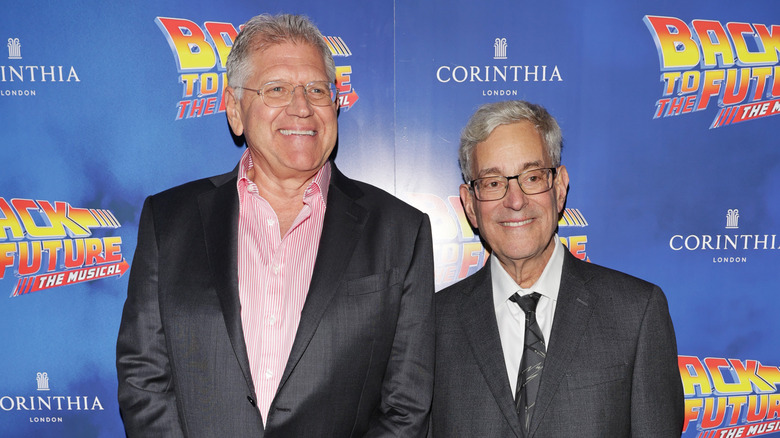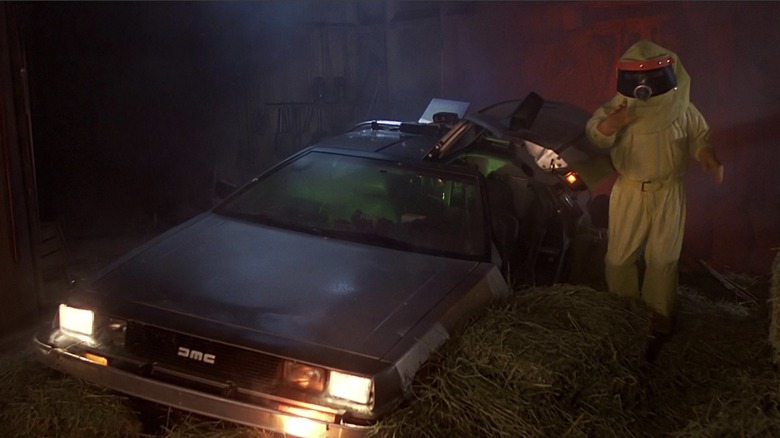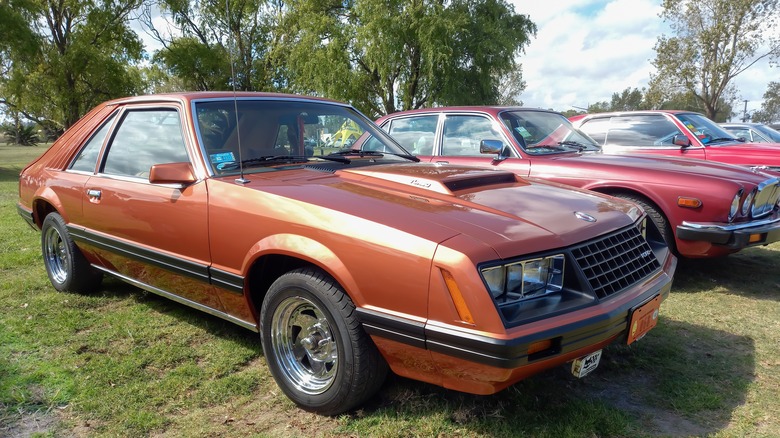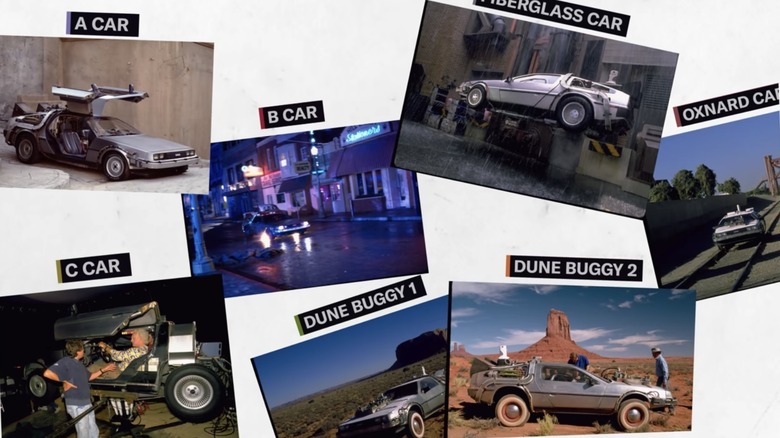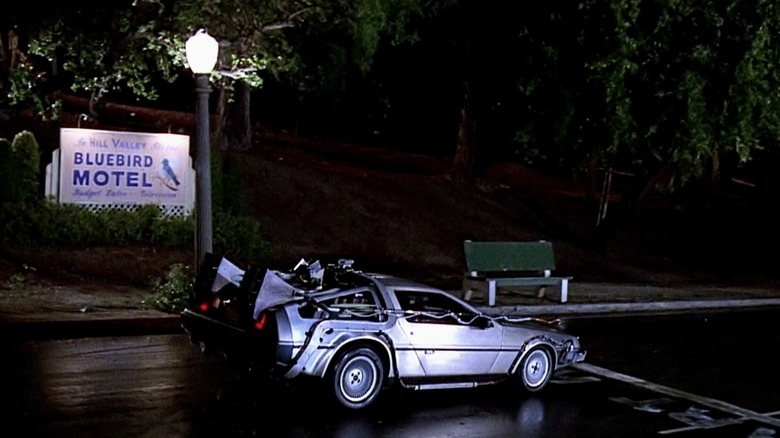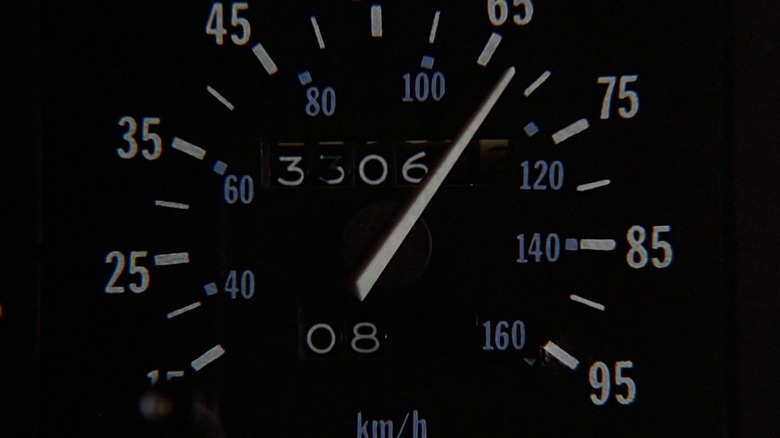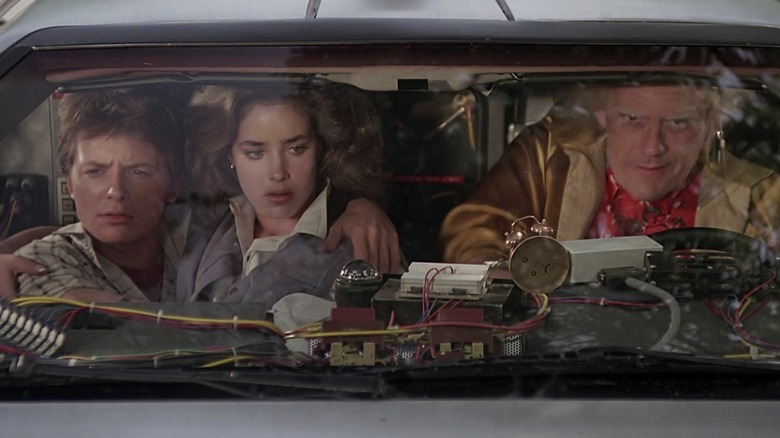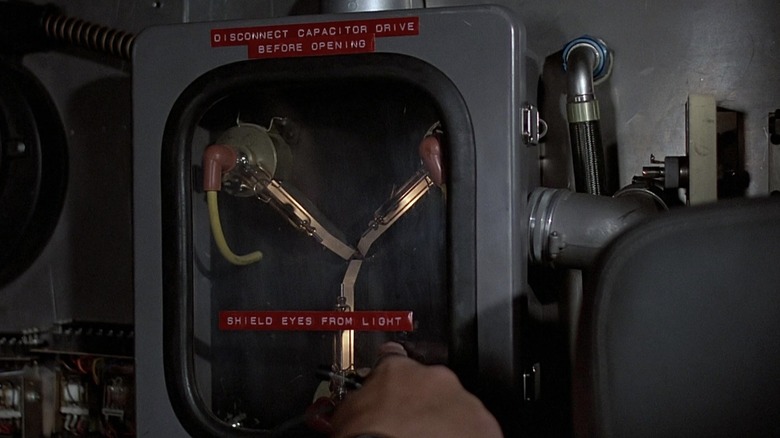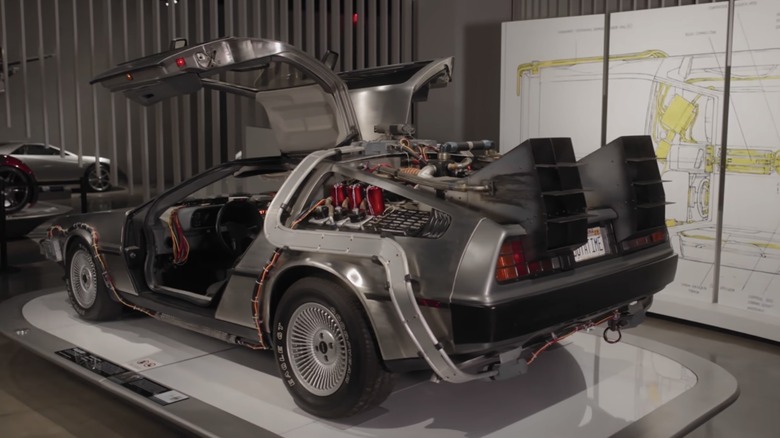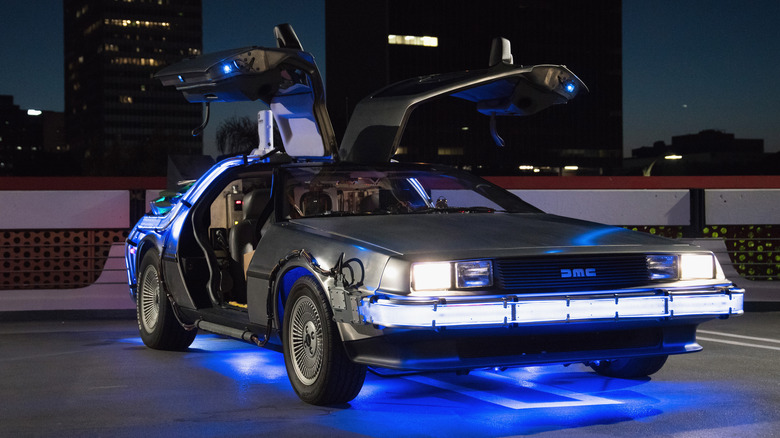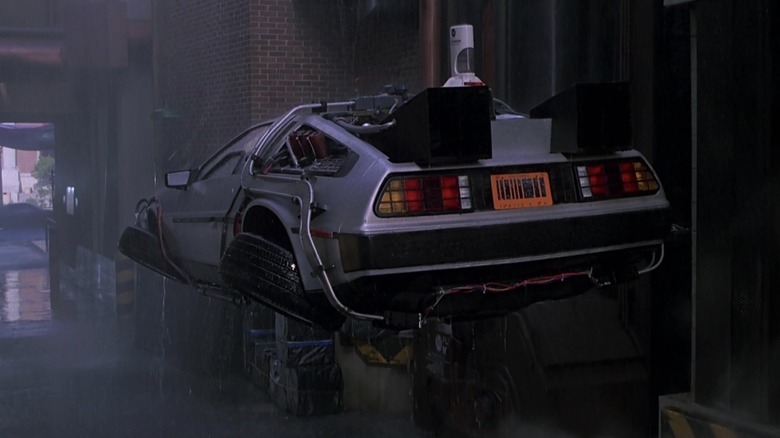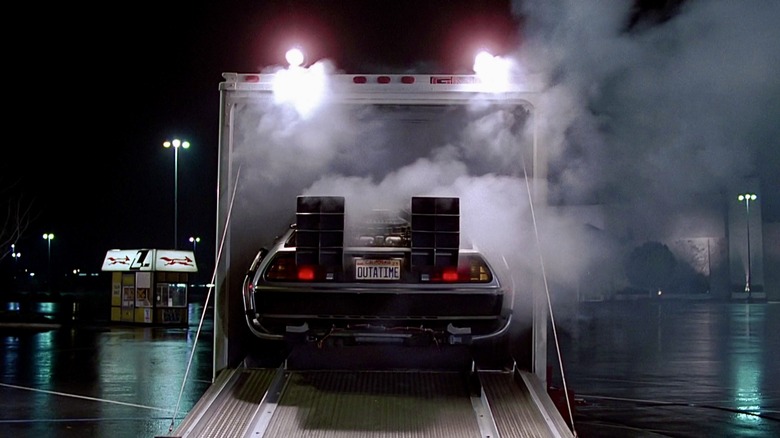The Untold Truth Of Back To The Future's DeLorean DMC-12
When "Back to the Future" hit movie screens, it captured the imagination of multiple generations, drawing on the nostalgia of Baby Boomers and the Silent Generation while sparking curiosity about the past in Gen-X. Finding the perfect balance between heartfelt and humorous, the sci-fi comedy about a teenager, Marty McFly (Michael J. Fox), who travels back in time and meets his parents when they were his age, blew audiences away and became the biggest movie of 1985. The comedic chemistry between Fox and Christopher Lloyd, who portrayed time machine inventor Doc Brown, set the movie up for success. But the film had another star that would leave an indelible mark on American pop culture.
The DeLorean DMC-12 was only in production for two years and its Irish factory had already closed before "Back to the Future" made the iconoclastic car a movie star. Although the DMC-12 was a commercial failure and disappointment amongst sports car enthusiasts, "Back to the Future" turned the car into a collectible oddity. The popularity of the film trilogy guaranteed the DMC-12 a place in Hollywood history, but the controversy surrounding the car's maverick creator intensified the public's fascination with the vehicle. Buckle up and join us for a ride through the untold history of how the DeLorean DMC-12 went from a failed automotive startup to a cinematic icon.
The DMC-12 was the brainchild of John Z. DeLorean
The true story behind the DeLorean DMC-12 is wild, and the man behind the iconic car is a huge part of that story. John DeLorean was the youngest division head in General Motors' history. The engineer was responsible for the Pontiac GTO and the Pontiac Firebird when he was the head engineer at Pontiac. After the success of the GTO, DeLorean's personality and lifestyle changed and tensions between himself and other GM executives grew. DeLorean left GM in 1973 after a speech he had written that was critical of GM's direction was leaked to the press.
The maverick engineer founded the DeLorean Motor Company in 1975 with the dream of disrupting the automotive industry with a sports car that was safe, sustainable, and fuel-efficient. Hollywood celebrities like Sammy Davis Jr. and Roy Clark were early investors in the company. Despite its futuristic look and early interest, the DMC-12 wasn't everything DeLorean had promised and the new motor company experienced funding issues before the factory in Northern Ireland had begun production.
Giorgetto Giugiaro, the lauded automotive designer, based the DMC-12 on his design for the Porsche Tapiro, a one-off concept car. Giugiaro also designed the Lotus Esprit, which became James Bond's underwater car in 1977's "The Spy Who Loved Me," suggesting that the DeLorean was destined for the silver screen. "I didn't expect that it could be picked as a movie car," Giugiaro told CNN, adding, "I'm glad when someone remembers that I designed it."
John DeLorean was arrested for drug trafficking
In October 1982, John DeLorean was arrested for drug trafficking after a meeting at a hotel room with James Hoffman, who was working with the FBI as an informant. DeLorean was charged with conspiracy to distribute 55 pounds of cocaine, with a street value of $25 million, in what most believed was a desperate attempt to raise funds to save his fledgling motor company. Weeks after DeLorean's arrest, the DeLorean Motor Company declared bankruptcy.
In 1984, DeLorean was acquitted by a jury that ruled Hoffman and the FBI had entrapped the automotive innovator, but the damage had been done to both his company and his public standing. DeLorean's financial and legal troubles continued after his motor company went belly-up. DeLorean was accused of misappropriating funds and was sued by investors. This lawsuit revealed that Johnny Carson had never invested in the DeLorean Motor Company, as many have claimed, although the former "Tonight Show" host did buy stock in the business.
The British government also investigated DeLorean, who faced trials for fraud and embezzlement in the U.S., although he was never convicted. Civil suits settled in the decades following the dissolution of the DeLorean Motor Company drove DeLorean to bankruptcy. He was evicted and forced to sell his New Jersey estate in 2000. Donald Trump bought DeLorean's estate in 2002 and turned it into a golf course. John DeLorean died at 80, after a stroke, in 2005.
The time machine wasn't always a car
The time machine for the "Back to the Future" trilogy wasn't always the iconic DeLorean DMC-12. In an early iteration of the script, the time machine was a refrigerator that Doc Brown carted around in the back of a pickup. "We actually had thought of putting a time machine in a refrigerator at one point," director and co-writer Robert Zemeckis told the Santa Barbara Film Festival. "But you had to get in and close it before it would start, and then we worried that kids would start locking themselves in refrigerators."
Not only was the time machine originally a refrigerator, but an early version of the "Back to the Future" script almost nuked the fridge 25 years before everyone's favorite archeologist did so in "Indiana Jones and the Kingdom of the Crystal Skull." In an early version of the script, the fridge was driven into a nuclear test site in the back of a truck, so the time machine could harness the power of the nuclear blast, sending Marty McFly back to 1985.
After being told they needed to cut the budget by $1 million, Zemeckis and writer-producer Bob Gale eventually realized that a lightning strike supplying the 1.21 gigawatts the flux capacitor needed to travel through time was a much more elegant solution. Thus, "Back to the Future" was saved from the ridicule "Indiana Jones" experienced after the fourth film in his franchise depicted Jones (Harrison Ford) surviving an atomic blast while inside a lead-lined refrigerator.
Robert Zemeckis suggested the car should be the time machine
After Robert Zemeckis and his writing partner, Bob Gale, decided that the time travel machine should be mobile, Gale told Box Office Mojo, "Zemeckis came up with this idea that it would be cool to use a DeLorean because it could be mistaken for a flying saucer." As Doc Brown said in the first film, "The way I see it, if you're gonna build a time machine into a car, why not do it with some style?" Zemeckis clearly was of the same mind as Doc Brown and used the DeLorean because of its futuristic look.
"We chose the DeLorean basically because it was the only car that existed that had gull-wing doors and would look kind of like a spaceship to someone in the '50s," Zemeckis told the Hollywood Foreign Press Association (HFPA) in a 1985 interview, after "Back to the Future" was nominated for numerous Golden Globes. When Marty crashes into a barn on Mr. Peabody's farm after arriving in 1955, Peabody's son is quick to make the connection between the DMC-12 and a spaceship, showing his family the cover of the comic book he was reading about aliens from outer space.
Ford tried to pay Universal Pictures to use a Mustang
After Robert Zemeckis and Bob Gale decided that the time machine must be a car, automotive giants courted the studio. Ford reportedly offered the studio $75,000 if they used a Mustang in "Back to the Future," which wasn't an unreasonable request considering how the liberal use of product placement helped epitomize the time periods Marty and Doc visit during the three films. Gale was quick to shut this down with his epic retort, "Doc Brown doesn't drive a f****** Mustang!"
The studio handled much of the product placement without input from Zemeckis and Gale, but the co-creators of "Back to the Future" did care which car was used as the time machine, and they had their hearts set on the DeLorean DMC-12. Rather than get paid $75,000 to use a Ford Mustang in the movie, Universal Studios instead went with the DMC-12 and made a licensing deal with John DeLorean in 1989, allowing Universal Studios merchandising and commercial use for 5% of the revenue.
Universal modified six DMC-12s for the Back to the Future trilogy
Universal Pictures used six DMC-12s and created one fiberglass version for the "Back to the Future" trilogy. Robert Zemeckis and Bob Gale gave their designers little guidance but insisted that it look homemade since the eccentric scientist-inventor had constructed it in the privacy of his garage. Artist Ron Cobb, illustrator Andy Probert and production designer Larry Paull worked on renderings for the DMC-12 time travel machine. Mike Scheffe, the vehicle construction coordinator, along with special effects supervisor Kevin Pike's team, transformed multiple DeLoreans into time machines for the "Back to the Future" trilogy.
Keeping the DMC-12s in tip-top shape during production was a constant struggle because the cars were quite fragile and broke down often during filming. There were initially three cars modified for the first film. Car "A" was the big star in the film, while car "B" did stunt work, and car "C" was used for interior shots. For the second and third films, more cars joined the fleet of DeLoreans. They used the fiberglass replica for flying scenes. The "B car" was modified to go on the railroad tracks for the third film. The "desert car #1" and "desert car #2" were used for the last movie in the trilogy, when Marty travels to the Old West to retrieve Doc Brown before he is murdered by Biff's (Thomas F. Wilson) ancestor.
They replaced the DMC-12's engine to make it go faster
John DeLorean had plans to make a turbocharged version of the DMC-12. He even had a contract with Legend Industries, a U.S.-based company that would handle the turbocharged conversion. Sadly, his plans for a turbocharged DMC-12 were scrapped before the DeLorean Motor Company went bankrupt because Legend Industries itself went bankrupt while waiting for DeLorean Motor Company to fix their production and funding issues.
The DMC-12 only had 130 horsepower and accelerated from zero to 60mph in over 10 seconds, which wasn't as good as the sports car's contemporary competition. In 1981, the DeLorean's competition was the Porsche 911, another rear-engine sports car that was lighter and faster than the DeLorean. Universal Studios replaced the DMC-12's original V6 engine with a Porsche engine so that the car would go faster for the film. This alteration essentially created a supercharged version of the DMC-12, similar to what DeLorean planned on offering in response to complaints about the car's speed and power.
They had to replace the speedometer for the film
The original speedometer of the DMC-12 only reached 85 miles per hour because of a 1979 mandate signed into law by former president Jimmy Carter that capped speedometers at 85 miles an hour to deter speeding. The FX department had to swap out the speedometer with one that reached 95mph, adding a digital speedometer to the dashboard for accuracy and dramatic effect. While this might seem like a minor detail, the importance of hitting 88mph means switching out the DMC-12s speedometer was absolutely necessary for the film.
Why did they choose 88mph as the speed for time travel? Of course, there are scientific theories about rates of speed and wormholes that argue for the speed of 88mph being necessary for a DeLorean to travel through time, but Bob Gale reportedly told ComicBook (via ScreenRant), "First of all we wanted it to be a speed that somebody wouldn't accidentally drive at. The other thing is, it's easy to remember."
One of the DMC-12s in the trilogy was cut apart for production
One of the DMC-12s used in "Back to the Future," known as the "C" car, was cut apart so they could film the interior shots of the time machine. The cabin of a DeLorean, especially with all the stylistic modifications, was too cramped for a 35mm Panaflex camera and an actor to fit inside. The scenes filmed in the "C" car were shot on the back lot of Universal Studios and the background outside the cabin of the DMC-12 was projected. The "C" car was used for interior shots for all three films.
Michael J. Fox reportedly hated working with the DeLorean while filming the sci-fi trilogy, and the cramped interior was a source of his hatred. "It was the worst thing to drive," Fox told Nerdist, adding, "It had two gears, and I slammed the gears, and my hand would smash into the flux capacitor. My hand would be bleeding, my head would be bleeding ... and I had to clean it off to get to the 'Family Ties' set."
Michael Fink designed and helped name the flux capacitor
Visual effects consultant Michael Fink briefly worked with the art department on "Back to the Future," helping bring the car's designs into reality. Fink made the contribution of designing the look of the flux capacitor during his weeks working on the DMC-12 for the studio. "At that point in my career, I would get called in these little jobs and a few of them actually were projects where Ron Cobb had done concept work," Fink explained in an interview for Universal Pictures.
"I had worked on the interior of the Spinner, the Voight-Kampf Machine, and the Little Esper, for 'Blade Runner,' so Larry [Paull] was confident I could handle it. So, I started to work on the vehicle, and of course, the flux capacitor was a big issue." In an early version of the script during pre-production, the flux capacitor didn't have that name. It was called the Temporal Field Capacitor, but Robert Zemeckis knew he needed something an actor could say without stumbling over the words. While discussing the prop with Zemeckis, Fink offered the term "neutron flux" before Fink and Zemeckis said "flux capacitor" in unison, and the term was coined.
The DMC-12 was prone to malfunctions on set
Although "Back to the Future," secured the DeLorean DMC-12 a place in cinematic history, the filmmakers admitted it wasn't always a cooperative star. "As cool as it looks on film, it's by no means a performance car," Gale told Esquire, adding, "It broke down a lot, and little things on the car would break during a scene, and we'd have to wait for the FX guys to repair it."
The gull-wing doors on the DMC-12 ruined multiple takes during one exceptionally chilly night filming the lightning strike scene. The doors of the DMC-12 are supposed to remain up because of gas-filled cylinders, but the doors wouldn't stay open in the frigid cold conditions. The crew resorted to warming the cylinders with hairdryers between takes to keep the doors open while filming.
Although Michael J. Fox and Christopher Lloyd became friends over the years while filming the trilogy, Fox never expressed kind words about his other famous co-star. "I wish I had a video, a gag reel of how many times I was hit by that freakin' door, the DeLorean door," Fox told Nerdist, adding "Take after take, it would go, WHACK!" Despite not enjoying working with the DMC-12, Fox must have recognized they made a dynamic duo on-screen.
Back to the Future's main DMC-12 is now in a museum
The "hero car," or car "A," which was featured in most scenes and beauty shots from the "Back to the Future" trilogy, was used for years by Universal Pictures and Universal Studios for promotional purposes. The "Back to the Future" theme park ride was filmed with the "A" car, but after years of use, it was left to the elements and began to deteriorate. Fans took pieces of the car for memorabilia, and it was in sorry shape.
The "hero car" was given a museum-quality restoration by Terry Matalas and superfan Joe Walser, who had already made a couple of replicas before convincing Universal to allow a team to take on the restoration. The 20-person team spent over a year restoring the DeLorean to its pristine film-star condition. After the restoration was completed in 2013, the "hero car" was displayed at the Universal Experience. In 2016, the hero car was loaned to Petersen Automotive Museum in Los Angeles by Universal and has been on display there ever since.
In 2021, the "hero car" became the 29th car added to the National Historic Vehicle Register because of its cultural significance. "The DeLorean Time Machine is among the world's most recognizable and beloved automobiles," Jonathan Klinger, Hagerty's vice president of car culture announced (via Hagerty), adding, "It transcends borders and generations, and it appeals to an audience far beyond the car community."
The other Back to the Future cars met different fates
The fiberglass replica that was used in the flying scenes in the sequel was put on display at Universal Studios but was destroyed years later. The "B" car, nicknamed the "wreckage car" did all the stunts and was destroyed by the train after it was retrofitted with train wheels for the climax of the third film. Parts of the "B" car were used in replicas, and some panels were hung from the ceiling of Planet Hollywood, Hawaii. The car later became part of a private collection owned by father-son duo Bill and Patrick Shea.
The "C" car was altered and cut apart so they could film interior shots for the "Back to the Future" trilogy. Many parts from the "C" car were used to build a replica for Universal Studios, Japan. A private company ultimately purchased this replica, and it is displayed at their entrance. The "Oxnard car" was a stunt car that was displayed at Universal Studios, Florida before being put in storage, where it still languishes. Two "desert" cars were also used while filming the third movie in Monument Valley. One was restored for a private collection, and the other "desert" car was initially used for parts. What remained of the "desert car" was later combined with parts from the "C" car to make a replica for display in Japan.
Back to the Future made the DMC-12 a collector's item
The DMC-12 has become a collector's item, in part because of how few were made, but also because of the popularity of the "Back to the Future" movies. According to the DeLorean Owners Association, there are approximately 6,000 DMC-12s still out there. Some of these DeLoreans are owned by DeLorean enthusiasts, while many fans of the film franchise have turned DeLoreans into "Back to the Future" replicas. While some "Back to the Future" enthusiasts, who are motorheads, choose to trick out their replicas themselves, others pay a pretty penny to buy them modified by a professional.
According to The Robb Report, a "near perfect" replica went up for auction in 2023. Although there was no reserve price listed, buyers can expect to pay anywhere from $50,000 to $80,000 for a DeLorean DMC-12 tricked out like the movie version, although they have sold for as much as $110,000. If buying a replica is a little rich for your blood, you can rent a DMC-12 "Back to the Future" replica for events.
One rental company, DeLorean Time Machine, shares its proceeds with The Michael J. Fox Foundation to further Parkinson's research. DeLorean Time Machine was started by Oliver and Terry Holler, a married couple who built a replica together after Oliver was diagnosed with terminal cancer. Oliver miraculously recovered from cancer and the couple have since dedicated their time and replica to aiding the Michael J. Fox Foundation as members of Team Fox.
